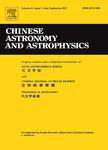版权所有:内蒙古大学图书馆 技术提供:维普资讯• 智图
内蒙古自治区呼和浩特市赛罕区大学西街235号 邮编: 010021

作者机构:Yunnan Astronomical Observatories Chinese Academy of Sciences Kunming 650011 China University of Chinese Academy of Sciences Beijing 100049 China Key Laboratory for the Structure and Evolution of Celestial Objects Chinese Academy of Sciences Kunming 650011 China Center for Astronomical Mega-Science Chinese Academy of Sciences Beijing 100012 China
出 版 物:《Chinese Astronomy and Astrophysics》 (Chin. Astron. Astrophys.)
年 卷 期:2018年第42卷第4期
页 面:527-537页
学科分类:0709[理学-地质学] 07[理学] 0708[理学-地球物理学] 0704[理学-天文学] 0825[工学-航空宇航科学与技术]
基 金:National Natural Science Foundation of China NSFC (11573062 115210001)
主 题:Abundances—galaxies evolution Galaxies ISM—galaxies
摘 要:In the galaxy parameter fitting by means of stellar population synthesis, it is found that compared with the evolutionary population synthesis (EPS) model without binary interactions, the stellar age and metallicity of a galaxy derived from the EPS model with binary interactions are larger. But, we are still unclear how the binary interactions affect the galaxy evolution. For the early-type galaxies with the UV-excess phenomenon, there are two main-stream explanations: recent star formation (RSF) and binary interactions. In this study, we obtain the mass return rate and chemical yield for the stellar populations with and without binary interactions. In combination with the galaxy chemical evolution and photoionization models, we study the effects of binary interactions on the chemical evolution and metallicity evolution for the early-type galaxies with the UV-excess phenomenon under the two formation mechanisms. We find that the inclusion of binary interactions can raise the ejected mass, metallicity, alpha element, and accelerate the gas cooling. These can reasonably explain the conclusions made by the EPS models. Moreover, we find that the gas cooling is more efficient under the UV-excess formation mechanism by the binary interactions rather than the RSF, and the ratio of element abundance is different for the two mechanisms, which can be further used to distinguish these two mechanisms. © 2018